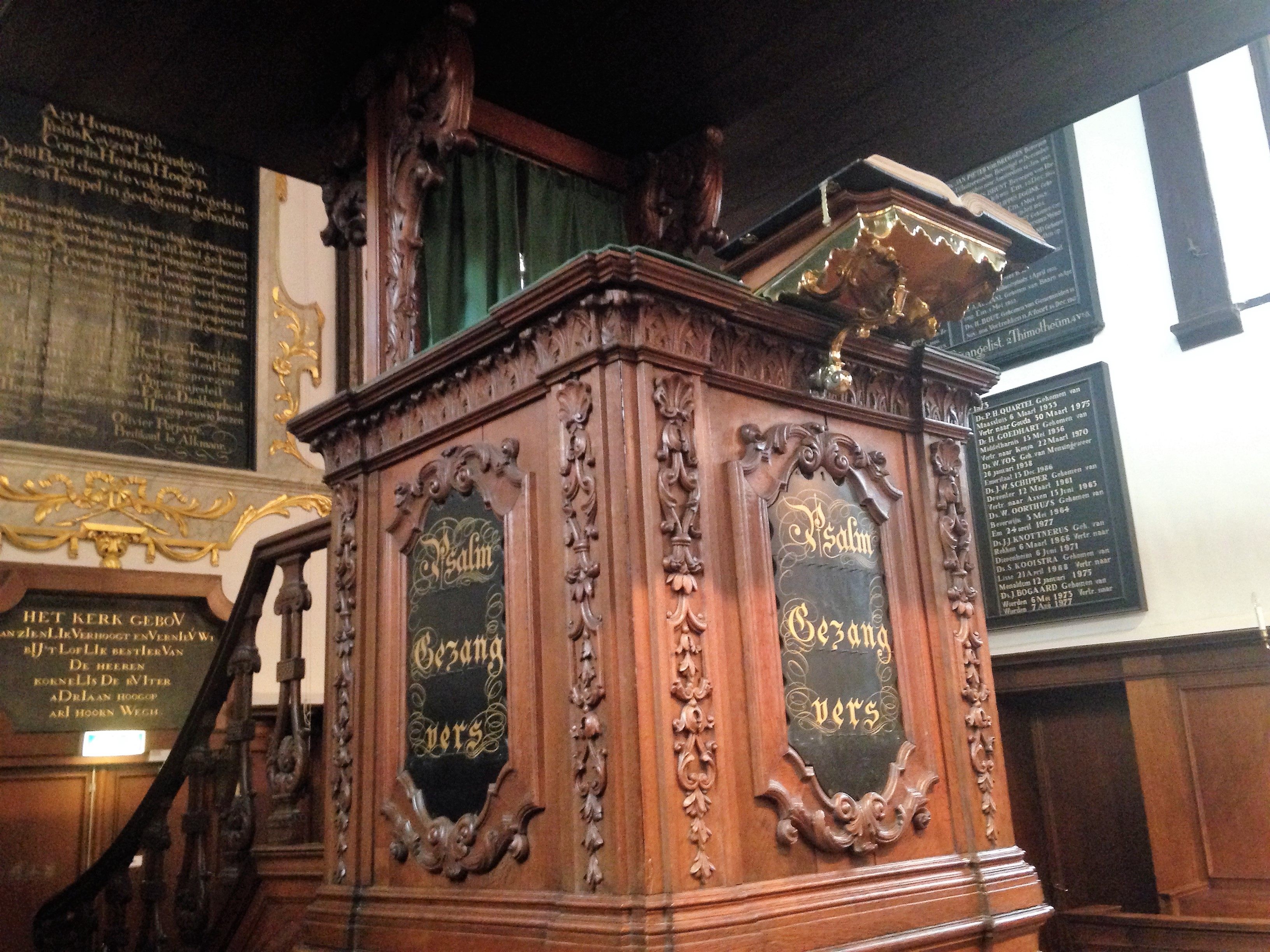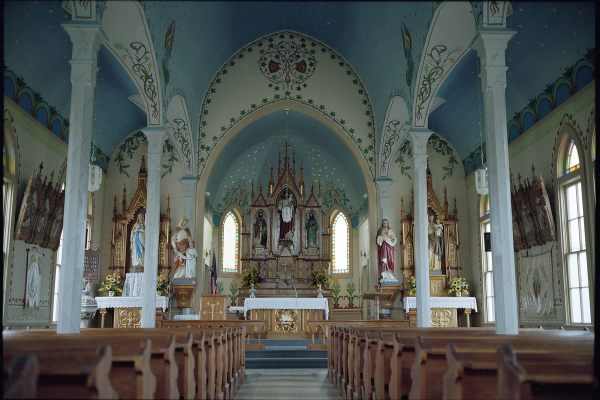The Centuries-Old Netherlands Church Celebrating American Thanksgiving
The Pilgrim Fathers’ Church has a long history.

It’s the church that celebrates America’s Thanksgiving. But it’s some 3,500 miles away from U.S. shores in the Netherlands.
On one wall hangs a bronze plaque, a “token of enduring gratitude and in Christian brotherhood” from the Boston Congregational Club, dated July 1906. On the opposite wall, a stone gifted by the New England Society of Chicago and dated Feb. 7, 1867 faces it. That stone, inscribed in Greek, “One Lord,” represents the last trace of a church that burnt down in Chicago’s Great Fire of 1871. The church had sent it to Rotterdam after receiving a small 16th century gravestone from Rotterdam to insert in its new building.
And in a museum in a back room, the Rotterdam church celebrates American leaders George W. Bush and President Barack Obama.
All of this is steps from a 17th-century windmill on a postcard-worthy Rotterdam canal, at the Pilgrim Fathers’ Church, which serves as a memorial and celebration of the pilgrims who may have prayed there before boarding the Speedwell, a ship slated to meet the Mayflower in 1620. But when the Speedwell sprang leaks, the pilgrims were able to book alternative passage on the Mayflower.

The church was founded in the early 15th century as a Catholic church devoted to saints Mary and Anthony but became Protestant following the Reformation. It has undergone several restorations and renovations over the century, including raising the floor to counter flooding and lifting the ceiling to improve ventilation. In the 18th century, it seems, parishioners used to use small, coal stoves to keep warm in the winter. The fumes from the stoves caused many to faint.
Later, it was given the name Pilgrim Fathers’ Church to honor the pilgrims’ final prayer site before setting out for the new world. Every year, the Pilgrim Fathers’ Church hosts a Thanksgiving celebration. Americans living abroad join congregants for a traditional meal and special church services.
The church’s history represents a preamble to the Thanksgiving story, which isn’t as well known as the aftermath of the landing on Plymouth Rock. The pilgrims, notes an essay in a book on sale in the church about its history, were real people, not symbols.
“The national myth of a glorious American past has loved to praise them as a kind of model democrats, founders of the American Commonwealth and as the chosen people which founded ‘God’s own country’ in the wilderness,” notes the essay “On the Move as Pilgrims” by professor J.W. Schulte Nordholt. “Or the other way round, they were portrayed as a small group of bigoted Puritans, anchored on the rock of Plymouth, intolerant towards their fellowmen, daming down all human pleasure, alcohol, sports and games, in short: a community of hypocrites.”

Like all historical figures, the professor argues, the pilgrims should be seen as important in their own right and their own times. “Let us try to see them as they saw themselves,” he writes.
Here’s how that portrait looks. A group that had separated from the Church of England fled to Holland, settling ultimately in Leiden, about 20 miles north of the Pilgrim Fathers’ Church. There, over nearly a 12-year period, the Brownists—for its leader Robert Browne—grew to about 100. When Browne chose to return to the Anglican church, the group began referring to itself as pilgrims, with John Robinson as its leading pastor.
Although they found religious tolerance in Leiden, the pilgrims didn’t find it to be edenic by any means. Leiden’s morals weren’t sufficiently strict for the pilgrims, Schulte Nordholt writes. “Their youngsters became rebellious and wanted to play at ball and ‘kolf’ and more of such worldly amusements with their Dutch friends, even on the day of the Lord.” (Kolf is a Dutch game, perhaps dating back to the Middle Ages, which is credited as an inspiration for golf.)
When the separatists finally had secured arrangements to travel to the new world, the “sade and mournfull parting” was a “truly dolfull” sight, wrote William Bradford, who would go on to become a Plymouth governor. “To see what sighs and sobbs and praiers did sound amongst them, what tears did gush from every eye, and pithy speeches peirst each harte; that sundry of the Dutch strangers that stood on the key as spectators, could not refrain from tears.”

The rest of the story is well known. After the Speedwell “leaked as a sieve,” as the professor puts it, the pilgrims crossed the ocean on the Mayflower, upon which they drafted the Mayflower Compact. But their troubles were only beginning. Half of the group died within the first two months: January and February. That the others survived was thanks to the help of American Indians, who taught them to grow corn and catch fish.
That the pilgrims faded into obscurity is a testament to their aim simply to live quiet and peaceful lives. But tracing one’s ancestry back to the pilgrims has become a sort of American gentility. Revealed in museum exhibits are historical tidbits about pilgrims’ descendants living today that would surprise. “Many famous Americans, such as former president George Bush, are direct descendents of the pilgrims,” notes a video in the church’s museum, displaying a photograph of George W. Bush. In 1989, George H.W. Bush had visited Leiden, and in remarks there, he referred to his ancestor Abigail Jenney, who was born in Leiden.
“I’m glad to be back with my cousins, because we fondly remember Aunt Abigail back there those many years ago,” he said at the time.

Back in the museum in the Rotterdam church, a poster on a wall lists nine U.S. presidents who can trace their ancestors to the Speedwell, including both Bushes. The others are: John Adams, John Quincy Adams, Zachary Taylor, Ulysses S. Grant, James Garfield, Franklin D. Roosevelt, and Barack Obama. An asterisk beside the latter’s name adds, “Obama is a descendent of a pilgrim, who came to America on Mayflower II in 1629.” As an article in the Quincy, Mass.-based Patriot Ledger recorded in 2009, the president’s ancestor, Thomas Blossom, came to the new world nine years after the Mayflower sailed, but in a ship of the same name.
In addition to being a surprising offering of Americana amid a city and scene that is entirely Dutch in every other regard, Pilgrim Fathers is a fascinating church for entirely domestic reasons. The church, whose active members number about 1,200, attracts some 400 people a Sunday, says Rikko Bulten, a Rotterdam-based tour guide, who runs a bed and breakfast. Bulten joined the church nine years ago and was part of a group that decided seven years ago to open the church to visitors twice week.
Bulten thinks three things will most surprise visitors to the church. First, it’s extensively decorated for a Protestant church. On Sundays, it is full of parishioners, unlike many other churches. And despite the fact that the pilgrims spent just a day and a night there “before the tide called them away,” Bulten says, “it’s still an important spot along the pilgrim fathers trail.”

One sign of the church’s unique story is its spire, which features not a cross but a sculpture of a herring – Rotterdam’s symbol – and its stained glass windows honor the nautical heritage the church represents.
If the essay by Schulte Nordholt is to be believed, Thanksgiving itself has its roots in The Netherlands. “That idea arose from having seen how the third of October—the day of the deliverance of the city of Leiden from the Spanish siege in 1574—was still being celebrated in Leiden,” Schulte Nordholt writes. “In this way, the Dutch left their mark on the American world, although herring and white bread changed into turkey.”















Follow us on Twitter to get the latest on the world's hidden wonders.
Like us on Facebook to get the latest on the world's hidden wonders.
Follow us on Twitter Like us on Facebook